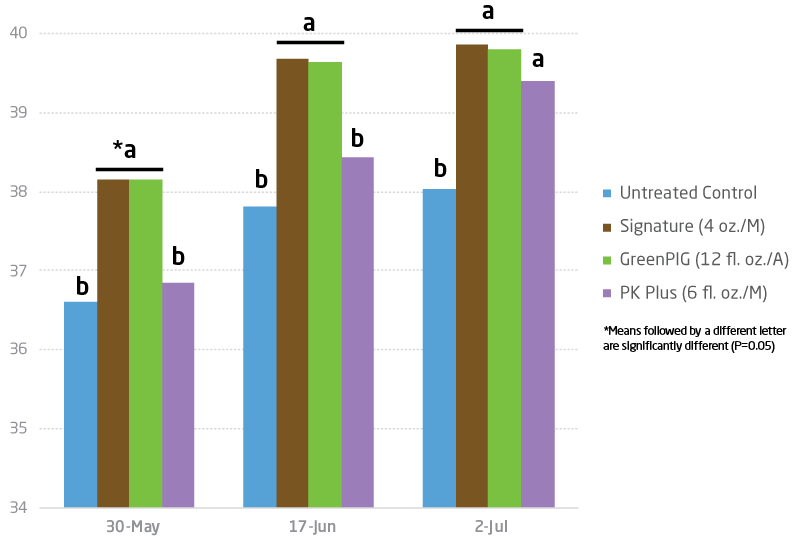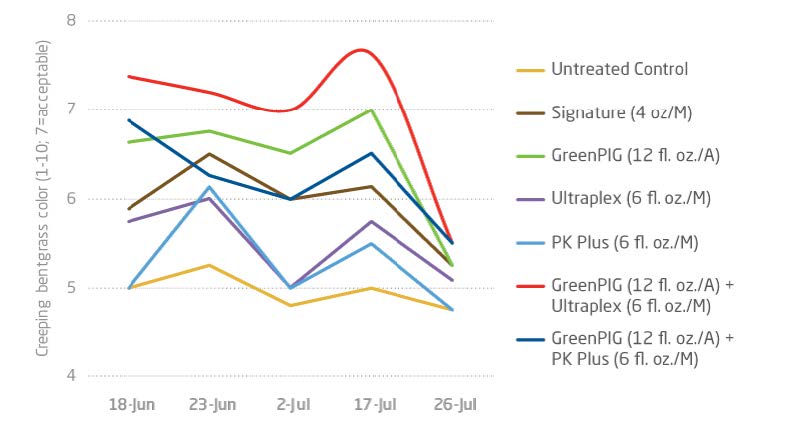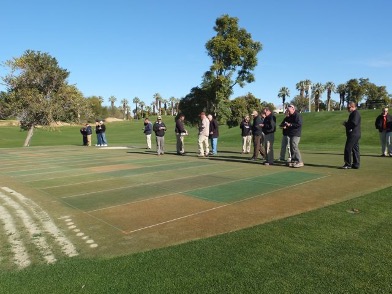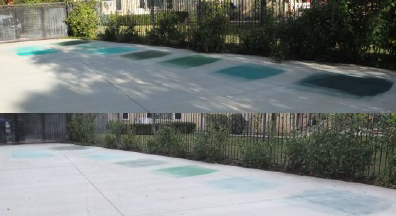Effect of Colorant and Foliar Fertilizer Applications on Turf
August 31, 2021
At BRANDT, we value and strive to offer high performance product offerings backed by science. Colorants have been used over the years to improve turfgrass color cosmetically, when applied to both actively growing and semidormant turfgrass. This can have important implications for golf courses where water restrictions are in place.
Based on our, and practitioners’ early observations, we set out to determine if colorants also improved turf quality – thus plant health. We hypothesized that colorants would allow plants to absorb more photosynthetically active light (400- 730 nm) and reflect potentially harmful near infrared (NIR) light (780). Excess NIR light absorption may lead increased heat production and oxidative stress.
We studied these effects on an actively growing creeping bentgrass (Agrostis stoloniferous – cultivar G-6) sward by measuring light absorbance and reflectance (Holland Scientific Crop Circle mounted to TurfScout cart using sub-meter GPS) after various colorant and foliar fertilizer applications. Measurements included 670, 730, and 780 nm wavelengths. Plots were 25 sq ft with 4 replications. The turf was droughts stressed, when possible, and nitrogen (N) inputs kept. Treatments were applied every 14 days and response measurements taken every 14 days and another 4X after the final application.
GRIGG® GreenPIG™ and Signature fungicide
significantly affected reflectance and absorbance
of light in the near infrared (NIR) bandwidth
(Figure 1).
These results indicate that colorants, in this case pigments, work to increase the reflection of potentially damaging NIR light, thereby protecting photosynthetic machinery. More effective light absorption occurs in the visible spectrum resulting in increased net photosynthesis. GRIGG GreenPIG treatments all produced the same effect (alone or with tank mix partner). In addition, and expectedly, colorant treatments applied alone or with a foliar fertilizer significantly improved turfgrass color (Figure 2).

Figure 1: Effect of colorant and foliar fertilizer applications on the reflectance of near infrared (NIR) light (McDonald, 2012).

Figure 2: Effect of colorant and foliar fertilizer applications on overall turfgrass color (McDonald, 2012).
What about applying colorants to dormant or semi-dormant turfgrass? For example, as substitute for overseeding. Generally, rates will need to increase, and practitioners will need to consider the color very carefully including pigments that fall more in the blue/green compared to yellow/green (Figure 3).

Figure 3: Turfgrass field day showing the effect (color) of different colorant applications. Product pigment contents (formulation) and rates have the largest effect on the final color (Baird, 2013).
BRANDT offers GRIGG GreenPIG Ultra for use on dormant turfgrasses. Other considerations based on our research include height of cut and photodecomposition. Generally, increased mowing heights will require higher rates, while the rate of photodecomposition determines the optimum reapplication interval (Figure 4).
Results for the work conducted at UC Riverside generated key recommendations for applying colorants as a substitute to overseeding. This guidance includes:
- Start applications before dormancy, or higher rates will be required
- If mowing, more frequent applications are likely necessary
- There can be up to a 5°F surface temperature increase following application, but the effect was short-lived and no significant differences among colorants tested was found.
- Avoid sidewalks or wash immediately.
- Colorants work best on monostands of a turfgrass species rather than mixed stands of warm- and cool-season grasses.
- Dry time typically 1-2 hours under optimal conditions. No significant differences found among treatments
In conclusion, colorants can have multiple benefits depending on the turf managers’ objectives. Routine applications can improve plant health by increasing the reflectance of potentially harmful NIR light, while encouraging greater absorption of photosynthetically active light. But currently, perhaps the most important use is as substitute for overseeding or in parts of the country where water restrictions are in place. It allows a tool for turf managers to maintain color and playability when water is limited and/or unavailable. This trend will likely continue well into future so plan accordingly and determine how colorants can be most effectively used the golf course property you manage.

Figure 4: Effect of photodecomposition on pigment effects (Baird, 2013). This effect determines the reapplication interval for most colorants. Always follow the colorant manufacturers’ label to determine application intervals for dormant or semi-dormant turfgrass.
Colorant Best Management Practices
Colorants optimize turfgrass color and quality, specifically where reduced irrigation inputs are required. Routine applications will improve playing conditions, reduce mowing requirements and can be used as a substitute for overseeding under extreme water deficit conditions. To this end, colorants offer a valuable tool where local and state government mandated water restrictions are in place.
When applied to actively growing turf, GRIGG GreenPig colorants increase the reflection of near infrared (NIR) and UV light, protecting plants from harmful light that can lead to oxidative stress. When applied to dormant and semi-dormant turf, GRIGG GreenPig Ultra can improve golf course, field, or property aesthetics.
Colorants contain specific pigments, called phthalocyanine(s) that determine the final color after application. Those that contain more yellow-green pigments should be used routinely and applied to actively growing turfgrass and those that contain more blue-green pigments are safe to use on dormant or semi-dormant turfgrass, where drought and heat dominate. Typically, turf managers will use the former colorant(s) for a specific agronomic objective when applied to actively growing turfgrass, while the latter is used under water restrictions or as a substitute to overseeding.
Flagship product that contains high quality, concentrated pigments to provide a natural green color for up to one month. This colorant has also been documented to reflect potentially harmful near infrared light, which may improve turf quality and vigor. For best results, use routinely on actively growing turfgrass, as needed.
This formulation provides the same benefits as GRIGG GreenPig, plus a proprietary compound that helps reduce turf exposure to ultraviolet light. It provides a natural green color for up to 14-21 days. It is recommended to use routinely on actively growing turfgrass, as needed.
This formulation offers the same benefits as GRIGG GreenPig, but provides a darker green color for up to one month. It is recommended to use routinely on dormant or semi-dormant turfgrass, as needed.
